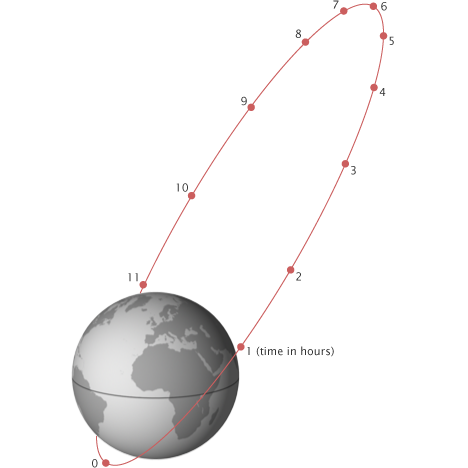"Molniya" orbit
Information about the “Molniya” orbit
“Molniya” orbit is one of high elliptical type of orbit with an inclination 63,4°, pericenter argument −90° and the orbital period equals to half of the sidereal day (image 1). This type of orbit was called by series of Soviet spacecrafts “Molniya”, which used this orbit for their work.
Most of the time on the orbit the satellite spends at apogee (the highest point in the orbit), which is going over the northern hemisphere. At the apogee orbit’s height could get 40 000 km, so that in connection with a long spending of time around the apogee, Satellite is greatly visible in the northern hemisphere, especially from Russia and Canada. Launching satellite on this orbit needs less fuel, than launching on the geostationary orbit.

Picture 1. “Molniya” orbit
For full covering of Russia needs at least 3 spacecrafts, each of them working for 8 hours during apogee. Since the Earth makes half of the rotation during 12 hours, every second apogee are in Russia, and another half – in Canada. Apogee’s longitude of three spacecrafts should be 90° of west and 90° of east latitude, but each of them should pass through the point after 8 hours after passing the last spacecraft. In this case when the spacecraft goes through the apogee’s point +4 hours and leaves the place of better broadcasting, the next spacecraft goes through the apogee’s point -4 hours and continues transmitting. The distance between spacecrafts during this change is 1500 km (in angular coordinates – several degrees), that is why retransmitting station needs to turn antenna a little to continue receiving information from the satellite.
The similar orbit to “Molniya” has the Russian Early warning system ICS“Kupol”, its orbit called “Tundra”.
You can use Gpredict software to find the NORAD ID of Molniya satellites. Visit this page to learn how to find the NORAD ID - Searching satellites for AR visualization
Visualization of the “Molniya” orbit
Add “Molniya” satellite type with NORAD ID 25485 (picture 2):

Picture 2. “Molniya” satellite
His orbit has an elongated shape (picture 3):

Picture 3. “Molniya” orbit in AR
The view of the satellite is illuminated on the globe – it’s really big. You can see that because of the elliptical elongated shape of orbit, the satellite is flying for a long time over the European part of Russia (several hours from 14:45 till 19:25).